Analysis of Analytics Usage in Organization: Adesa Openlane Report
VerifiedAdded on 2023/04/22
|12
|2752
|117
Report
AI Summary
This report delves into the application of analytics within Adesa Openlane, an organization identified as an analytical practitioner. It explores how the company leverages data, particularly from its website, to understand consumer behavior and inform strategic decisions. The report covers various aspects of analytics usage, including marketing analytics, organizational culture, product life cycle management, and new product development. It examines the effectiveness of the organization's informational value chain, demonstrating how analytics assists in understanding and driving value, and contributing to a competitive advantage. The report also discusses the propensity to incorporate analytics into the strategic decision-making process, highlighting areas for improvement, such as broader implementation of analytics across departments and the establishment of an expert team to monitor the analytics platform. The conclusion emphasizes the critical role of analytics in understanding past performance and guiding future business decisions through data-driven insights, mathematical and statistical calculations, and automation processes.
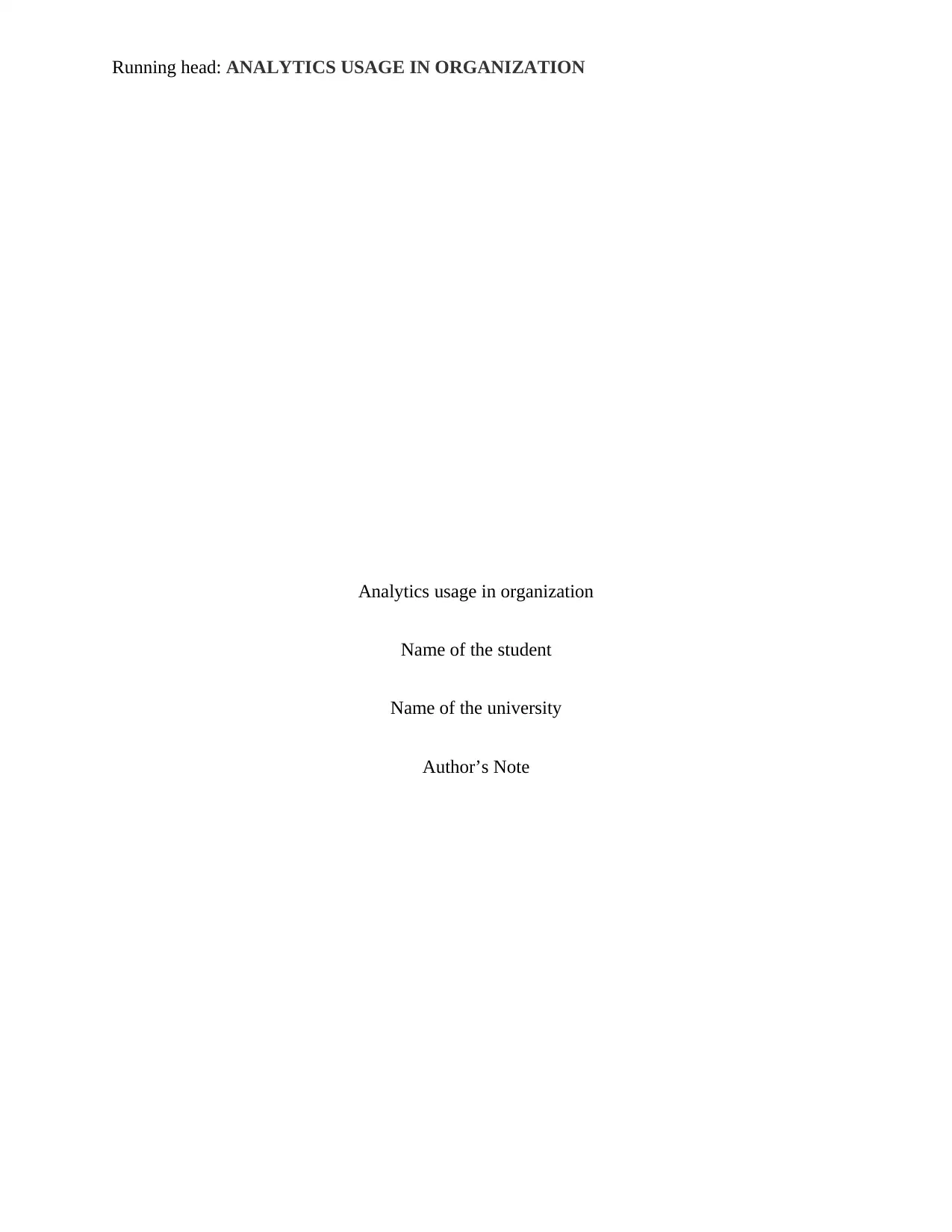
Running head: ANALYTICS USAGE IN ORGANIZATION
Analytics usage in organization
Name of the student
Name of the university
Author’s Note
Analytics usage in organization
Name of the student
Name of the university
Author’s Note
Paraphrase This Document
Need a fresh take? Get an instant paraphrase of this document with our AI Paraphraser
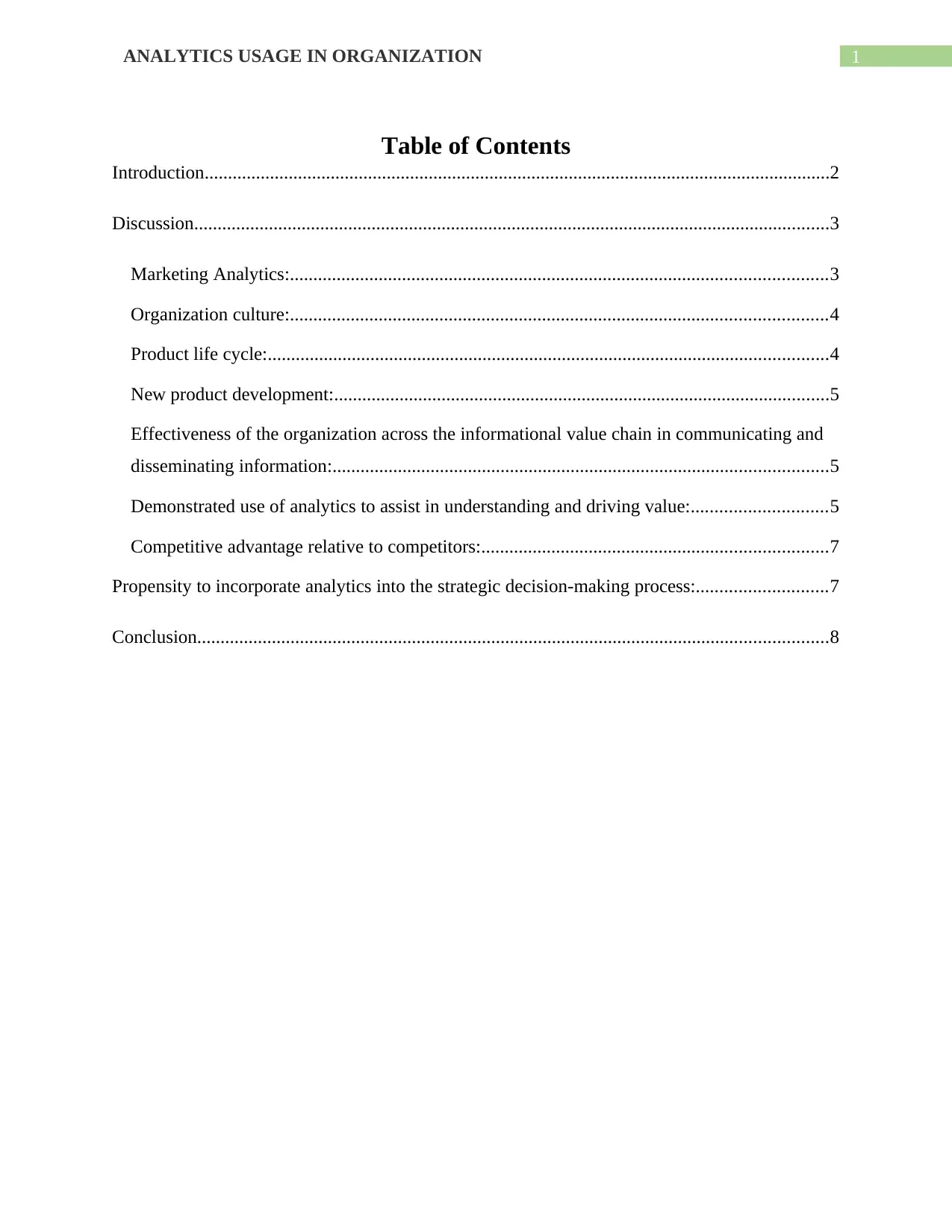
1ANALYTICS USAGE IN ORGANIZATION
Table of Contents
Introduction......................................................................................................................................2
Discussion........................................................................................................................................3
Marketing Analytics:...................................................................................................................3
Organization culture:...................................................................................................................4
Product life cycle:........................................................................................................................4
New product development:..........................................................................................................5
Effectiveness of the organization across the informational value chain in communicating and
disseminating information:..........................................................................................................5
Demonstrated use of analytics to assist in understanding and driving value:.............................5
Competitive advantage relative to competitors:..........................................................................7
Propensity to incorporate analytics into the strategic decision-making process:............................7
Conclusion.......................................................................................................................................8
Table of Contents
Introduction......................................................................................................................................2
Discussion........................................................................................................................................3
Marketing Analytics:...................................................................................................................3
Organization culture:...................................................................................................................4
Product life cycle:........................................................................................................................4
New product development:..........................................................................................................5
Effectiveness of the organization across the informational value chain in communicating and
disseminating information:..........................................................................................................5
Demonstrated use of analytics to assist in understanding and driving value:.............................5
Competitive advantage relative to competitors:..........................................................................7
Propensity to incorporate analytics into the strategic decision-making process:............................7
Conclusion.......................................................................................................................................8
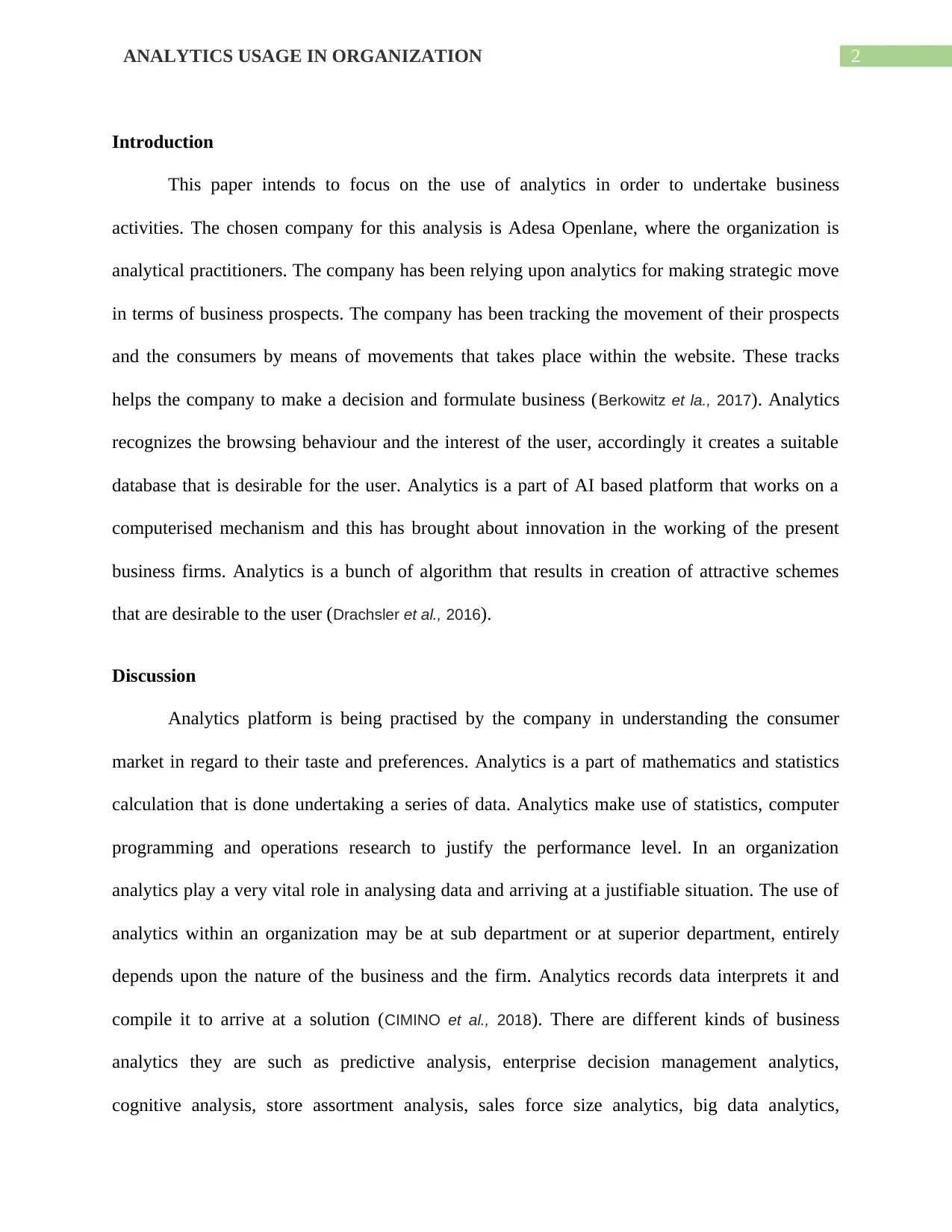
2ANALYTICS USAGE IN ORGANIZATION
Introduction
This paper intends to focus on the use of analytics in order to undertake business
activities. The chosen company for this analysis is Adesa Openlane, where the organization is
analytical practitioners. The company has been relying upon analytics for making strategic move
in terms of business prospects. The company has been tracking the movement of their prospects
and the consumers by means of movements that takes place within the website. These tracks
helps the company to make a decision and formulate business (Berkowitz et la., 2017). Analytics
recognizes the browsing behaviour and the interest of the user, accordingly it creates a suitable
database that is desirable for the user. Analytics is a part of AI based platform that works on a
computerised mechanism and this has brought about innovation in the working of the present
business firms. Analytics is a bunch of algorithm that results in creation of attractive schemes
that are desirable to the user (Drachsler et al., 2016).
Discussion
Analytics platform is being practised by the company in understanding the consumer
market in regard to their taste and preferences. Analytics is a part of mathematics and statistics
calculation that is done undertaking a series of data. Analytics make use of statistics, computer
programming and operations research to justify the performance level. In an organization
analytics play a very vital role in analysing data and arriving at a justifiable situation. The use of
analytics within an organization may be at sub department or at superior department, entirely
depends upon the nature of the business and the firm. Analytics records data interprets it and
compile it to arrive at a solution (CIMINO et al., 2018). There are different kinds of business
analytics they are such as predictive analysis, enterprise decision management analytics,
cognitive analysis, store assortment analysis, sales force size analytics, big data analytics,
Introduction
This paper intends to focus on the use of analytics in order to undertake business
activities. The chosen company for this analysis is Adesa Openlane, where the organization is
analytical practitioners. The company has been relying upon analytics for making strategic move
in terms of business prospects. The company has been tracking the movement of their prospects
and the consumers by means of movements that takes place within the website. These tracks
helps the company to make a decision and formulate business (Berkowitz et la., 2017). Analytics
recognizes the browsing behaviour and the interest of the user, accordingly it creates a suitable
database that is desirable for the user. Analytics is a part of AI based platform that works on a
computerised mechanism and this has brought about innovation in the working of the present
business firms. Analytics is a bunch of algorithm that results in creation of attractive schemes
that are desirable to the user (Drachsler et al., 2016).
Discussion
Analytics platform is being practised by the company in understanding the consumer
market in regard to their taste and preferences. Analytics is a part of mathematics and statistics
calculation that is done undertaking a series of data. Analytics make use of statistics, computer
programming and operations research to justify the performance level. In an organization
analytics play a very vital role in analysing data and arriving at a justifiable situation. The use of
analytics within an organization may be at sub department or at superior department, entirely
depends upon the nature of the business and the firm. Analytics records data interprets it and
compile it to arrive at a solution (CIMINO et al., 2018). There are different kinds of business
analytics they are such as predictive analysis, enterprise decision management analytics,
cognitive analysis, store assortment analysis, sales force size analytics, big data analytics,
⊘ This is a preview!⊘
Do you want full access?
Subscribe today to unlock all pages.

Trusted by 1+ million students worldwide

3ANALYTICS USAGE IN ORGANIZATION
marketing mix analytics, fraud analytics, speech analytics, retail analytics, call analytics and
much more. Within the business boundaries analytics is concerned with the understanding the
past and according making a present judgement using the available data and then acting
accordingly. Analytics helps in the planning phase (Wang et al., 2016).
Marketing Analytics:
Within the marketing boundaries, analytics helps in collection of data which mainly consists of
the consumer buying behaviour and patterns along with the price segments that influences their
mind and accordingly it enhance a strategic step to take action. Analytics provide a statistical
measure through which data are compiled, data such as cost related data, marketing related data,
trading related (Verhoef et al., 2016).
Organization culture:
Use of analytics within the organization culture is very common nowadays. With the changing
and more skilled labour force. The number of workers that are emerging this bring in the need of
maintaining a separate data storage platform to keep track of the existing data regarding the
cultural norms of the organization. Performance within the organization are measured and
marked with numerical performance number. Performance appraisal are also marked with certain
numerical numbers (Ransbotham et al., 2016). The number could be analysed in order to take
performance appraisal decisions accordingly. Analytics simply make use of existing data and
after compiling it the AI based platform helps in arriving at a particular solution.
Product life cycle:
The product life cycle is about the introduction stage which brings in the growth stage, then
comes in the maturity stage then at last comes in the decline stage. The various levels of PLC is
marketing mix analytics, fraud analytics, speech analytics, retail analytics, call analytics and
much more. Within the business boundaries analytics is concerned with the understanding the
past and according making a present judgement using the available data and then acting
accordingly. Analytics helps in the planning phase (Wang et al., 2016).
Marketing Analytics:
Within the marketing boundaries, analytics helps in collection of data which mainly consists of
the consumer buying behaviour and patterns along with the price segments that influences their
mind and accordingly it enhance a strategic step to take action. Analytics provide a statistical
measure through which data are compiled, data such as cost related data, marketing related data,
trading related (Verhoef et al., 2016).
Organization culture:
Use of analytics within the organization culture is very common nowadays. With the changing
and more skilled labour force. The number of workers that are emerging this bring in the need of
maintaining a separate data storage platform to keep track of the existing data regarding the
cultural norms of the organization. Performance within the organization are measured and
marked with numerical performance number. Performance appraisal are also marked with certain
numerical numbers (Ransbotham et al., 2016). The number could be analysed in order to take
performance appraisal decisions accordingly. Analytics simply make use of existing data and
after compiling it the AI based platform helps in arriving at a particular solution.
Product life cycle:
The product life cycle is about the introduction stage which brings in the growth stage, then
comes in the maturity stage then at last comes in the decline stage. The various levels of PLC is
Paraphrase This Document
Need a fresh take? Get an instant paraphrase of this document with our AI Paraphraser
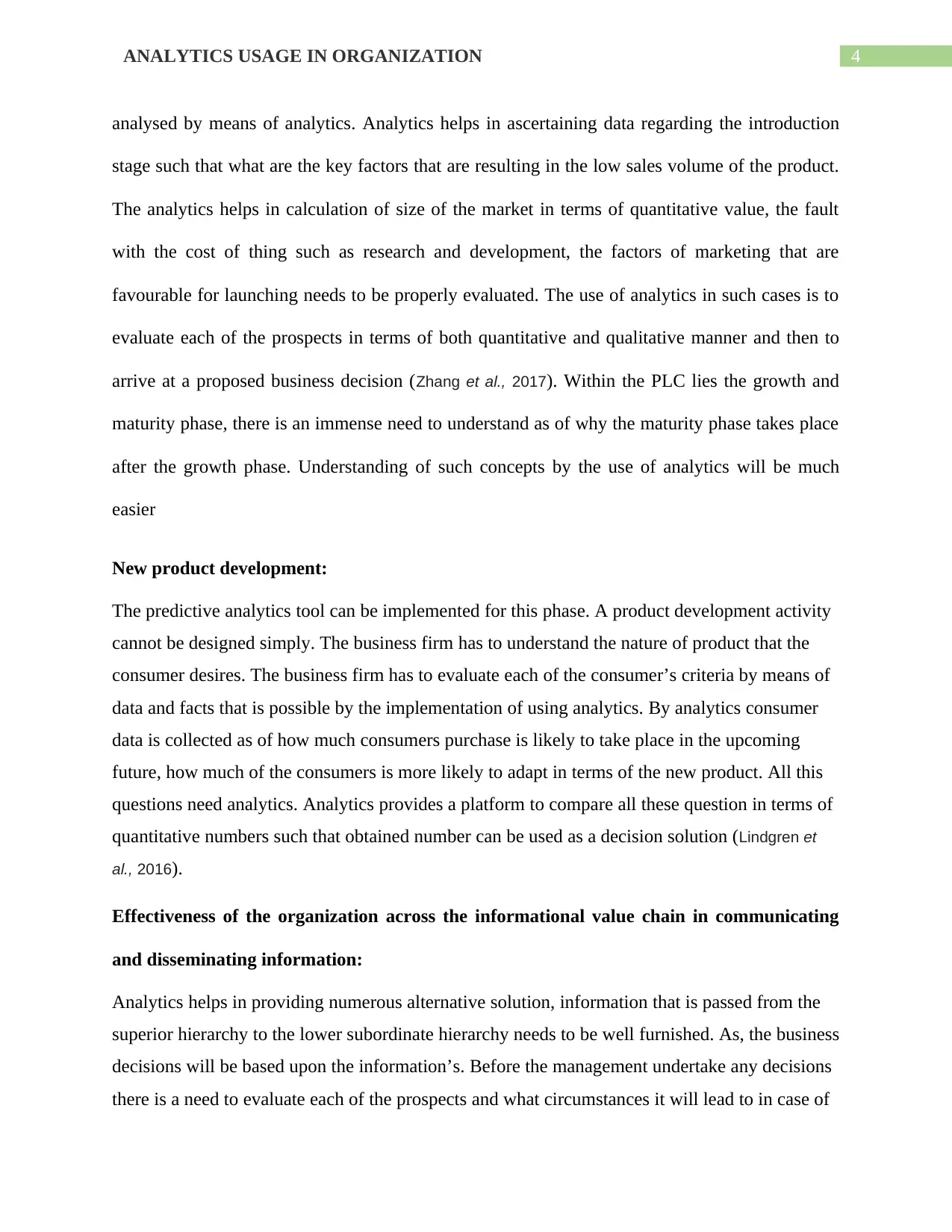
4ANALYTICS USAGE IN ORGANIZATION
analysed by means of analytics. Analytics helps in ascertaining data regarding the introduction
stage such that what are the key factors that are resulting in the low sales volume of the product.
The analytics helps in calculation of size of the market in terms of quantitative value, the fault
with the cost of thing such as research and development, the factors of marketing that are
favourable for launching needs to be properly evaluated. The use of analytics in such cases is to
evaluate each of the prospects in terms of both quantitative and qualitative manner and then to
arrive at a proposed business decision (Zhang et al., 2017). Within the PLC lies the growth and
maturity phase, there is an immense need to understand as of why the maturity phase takes place
after the growth phase. Understanding of such concepts by the use of analytics will be much
easier
New product development:
The predictive analytics tool can be implemented for this phase. A product development activity
cannot be designed simply. The business firm has to understand the nature of product that the
consumer desires. The business firm has to evaluate each of the consumer’s criteria by means of
data and facts that is possible by the implementation of using analytics. By analytics consumer
data is collected as of how much consumers purchase is likely to take place in the upcoming
future, how much of the consumers is more likely to adapt in terms of the new product. All this
questions need analytics. Analytics provides a platform to compare all these question in terms of
quantitative numbers such that obtained number can be used as a decision solution (Lindgren et
al., 2016).
Effectiveness of the organization across the informational value chain in communicating
and disseminating information:
Analytics helps in providing numerous alternative solution, information that is passed from the
superior hierarchy to the lower subordinate hierarchy needs to be well furnished. As, the business
decisions will be based upon the information’s. Before the management undertake any decisions
there is a need to evaluate each of the prospects and what circumstances it will lead to in case of
analysed by means of analytics. Analytics helps in ascertaining data regarding the introduction
stage such that what are the key factors that are resulting in the low sales volume of the product.
The analytics helps in calculation of size of the market in terms of quantitative value, the fault
with the cost of thing such as research and development, the factors of marketing that are
favourable for launching needs to be properly evaluated. The use of analytics in such cases is to
evaluate each of the prospects in terms of both quantitative and qualitative manner and then to
arrive at a proposed business decision (Zhang et al., 2017). Within the PLC lies the growth and
maturity phase, there is an immense need to understand as of why the maturity phase takes place
after the growth phase. Understanding of such concepts by the use of analytics will be much
easier
New product development:
The predictive analytics tool can be implemented for this phase. A product development activity
cannot be designed simply. The business firm has to understand the nature of product that the
consumer desires. The business firm has to evaluate each of the consumer’s criteria by means of
data and facts that is possible by the implementation of using analytics. By analytics consumer
data is collected as of how much consumers purchase is likely to take place in the upcoming
future, how much of the consumers is more likely to adapt in terms of the new product. All this
questions need analytics. Analytics provides a platform to compare all these question in terms of
quantitative numbers such that obtained number can be used as a decision solution (Lindgren et
al., 2016).
Effectiveness of the organization across the informational value chain in communicating
and disseminating information:
Analytics helps in providing numerous alternative solution, information that is passed from the
superior hierarchy to the lower subordinate hierarchy needs to be well furnished. As, the business
decisions will be based upon the information’s. Before the management undertake any decisions
there is a need to evaluate each of the prospects and what circumstances it will lead to in case of
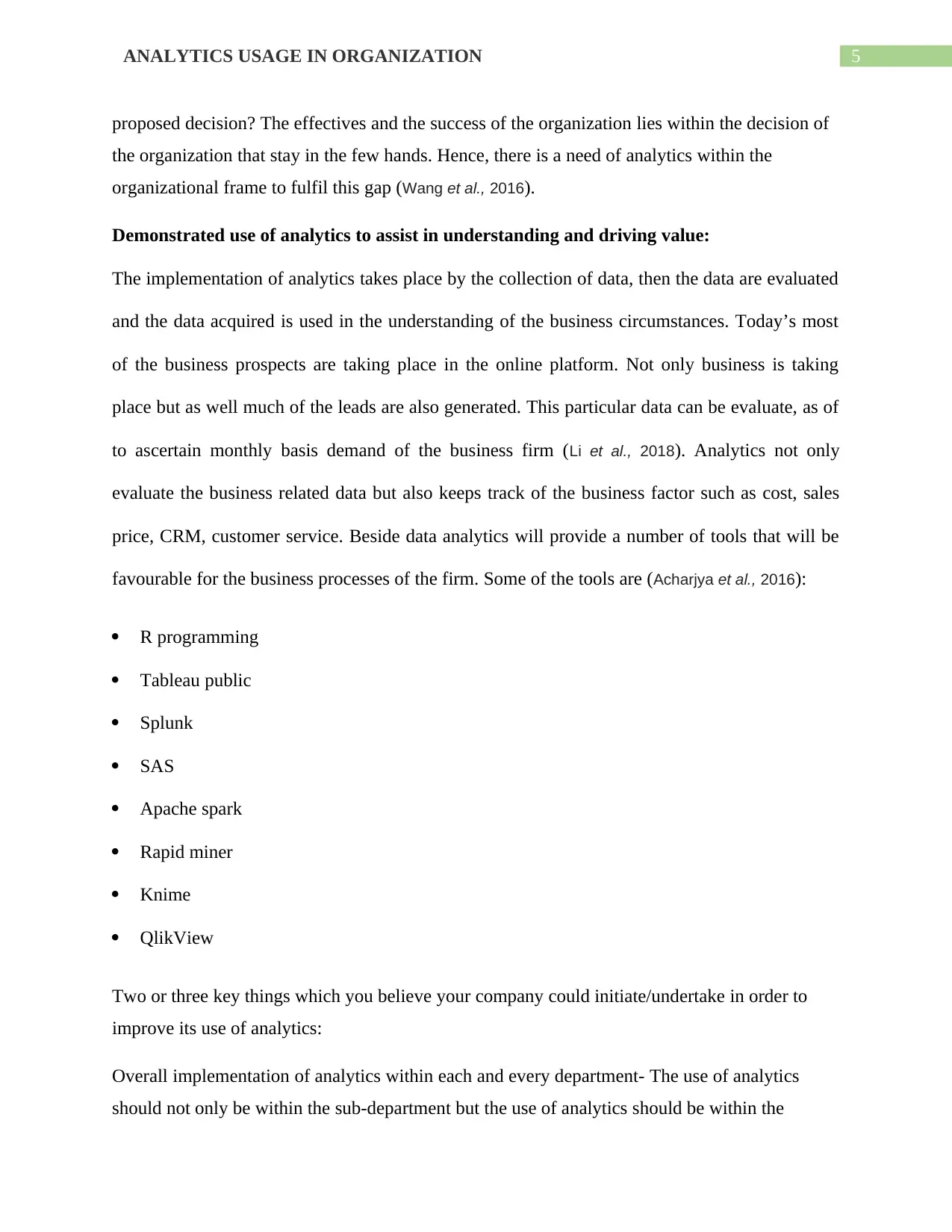
5ANALYTICS USAGE IN ORGANIZATION
proposed decision? The effectives and the success of the organization lies within the decision of
the organization that stay in the few hands. Hence, there is a need of analytics within the
organizational frame to fulfil this gap (Wang et al., 2016).
Demonstrated use of analytics to assist in understanding and driving value:
The implementation of analytics takes place by the collection of data, then the data are evaluated
and the data acquired is used in the understanding of the business circumstances. Today’s most
of the business prospects are taking place in the online platform. Not only business is taking
place but as well much of the leads are also generated. This particular data can be evaluate, as of
to ascertain monthly basis demand of the business firm (Li et al., 2018). Analytics not only
evaluate the business related data but also keeps track of the business factor such as cost, sales
price, CRM, customer service. Beside data analytics will provide a number of tools that will be
favourable for the business processes of the firm. Some of the tools are (Acharjya et al., 2016):
R programming
Tableau public
Splunk
SAS
Apache spark
Rapid miner
Knime
QlikView
Two or three key things which you believe your company could initiate/undertake in order to
improve its use of analytics:
Overall implementation of analytics within each and every department- The use of analytics
should not only be within the sub-department but the use of analytics should be within the
proposed decision? The effectives and the success of the organization lies within the decision of
the organization that stay in the few hands. Hence, there is a need of analytics within the
organizational frame to fulfil this gap (Wang et al., 2016).
Demonstrated use of analytics to assist in understanding and driving value:
The implementation of analytics takes place by the collection of data, then the data are evaluated
and the data acquired is used in the understanding of the business circumstances. Today’s most
of the business prospects are taking place in the online platform. Not only business is taking
place but as well much of the leads are also generated. This particular data can be evaluate, as of
to ascertain monthly basis demand of the business firm (Li et al., 2018). Analytics not only
evaluate the business related data but also keeps track of the business factor such as cost, sales
price, CRM, customer service. Beside data analytics will provide a number of tools that will be
favourable for the business processes of the firm. Some of the tools are (Acharjya et al., 2016):
R programming
Tableau public
Splunk
SAS
Apache spark
Rapid miner
Knime
QlikView
Two or three key things which you believe your company could initiate/undertake in order to
improve its use of analytics:
Overall implementation of analytics within each and every department- The use of analytics
should not only be within the sub-department but the use of analytics should be within the
⊘ This is a preview!⊘
Do you want full access?
Subscribe today to unlock all pages.

Trusted by 1+ million students worldwide

6ANALYTICS USAGE IN ORGANIZATION
overall department as it will not lead to effective performance of the business firm (Gunasekaran
et al., 2017).
Setting up a team of experts to supervise and monitor the analytics platform- The analytic is a
task of proficiency, a separate team is required to make sure that real time basis monitoring and
constant tracking of the analytics activity is being done.
Comparison of analytics report- The data and charts obtained could be compared with one
another, in order to better understand the nature of work. This will give a direction that the
company is moving towards growth or is at BEP (Pazmiño-Maji et al., 2016).
Implementing new plans on the judgement basis of analytics report- New business plan should
be implemented but on the basis of obtained analytical report to measure the efficiency and
effectiveness of the report.
Competitive advantage relative to competitors:
The use of analytics differs from one firm to another. However, the rival firms may not have
undertook the implementation of analytics. Moreover, the use of analytics also depends upon the
nature of work (Akter et al., 2016). Business analytics operates on firstly, business intelligence
which resembles to dealing with historical data and secondly, it deals with statistical analysis
which mainly deals with the mathematics and algorithms. There exists a set of different analytics
tool each mend for different specific purpose. Diagnostic analysis is one of the tool effective in
ascertaining a solution as such why something happened or took place.
Propensity to incorporate analytics into the strategic decision-making process:
All the compiled data can be provided to senior authorities by means of reports, the compiled
data can then be studied and MBO (Management by Objectives) are met or not can be evaluated.
Moreover, analytics contributes to database management system, DBMS helps in making the
senior managers aware of the current business scenario and accordingly undertake a business
overall department as it will not lead to effective performance of the business firm (Gunasekaran
et al., 2017).
Setting up a team of experts to supervise and monitor the analytics platform- The analytic is a
task of proficiency, a separate team is required to make sure that real time basis monitoring and
constant tracking of the analytics activity is being done.
Comparison of analytics report- The data and charts obtained could be compared with one
another, in order to better understand the nature of work. This will give a direction that the
company is moving towards growth or is at BEP (Pazmiño-Maji et al., 2016).
Implementing new plans on the judgement basis of analytics report- New business plan should
be implemented but on the basis of obtained analytical report to measure the efficiency and
effectiveness of the report.
Competitive advantage relative to competitors:
The use of analytics differs from one firm to another. However, the rival firms may not have
undertook the implementation of analytics. Moreover, the use of analytics also depends upon the
nature of work (Akter et al., 2016). Business analytics operates on firstly, business intelligence
which resembles to dealing with historical data and secondly, it deals with statistical analysis
which mainly deals with the mathematics and algorithms. There exists a set of different analytics
tool each mend for different specific purpose. Diagnostic analysis is one of the tool effective in
ascertaining a solution as such why something happened or took place.
Propensity to incorporate analytics into the strategic decision-making process:
All the compiled data can be provided to senior authorities by means of reports, the compiled
data can then be studied and MBO (Management by Objectives) are met or not can be evaluated.
Moreover, analytics contributes to database management system, DBMS helps in making the
senior managers aware of the current business scenario and accordingly undertake a business
Paraphrase This Document
Need a fresh take? Get an instant paraphrase of this document with our AI Paraphraser
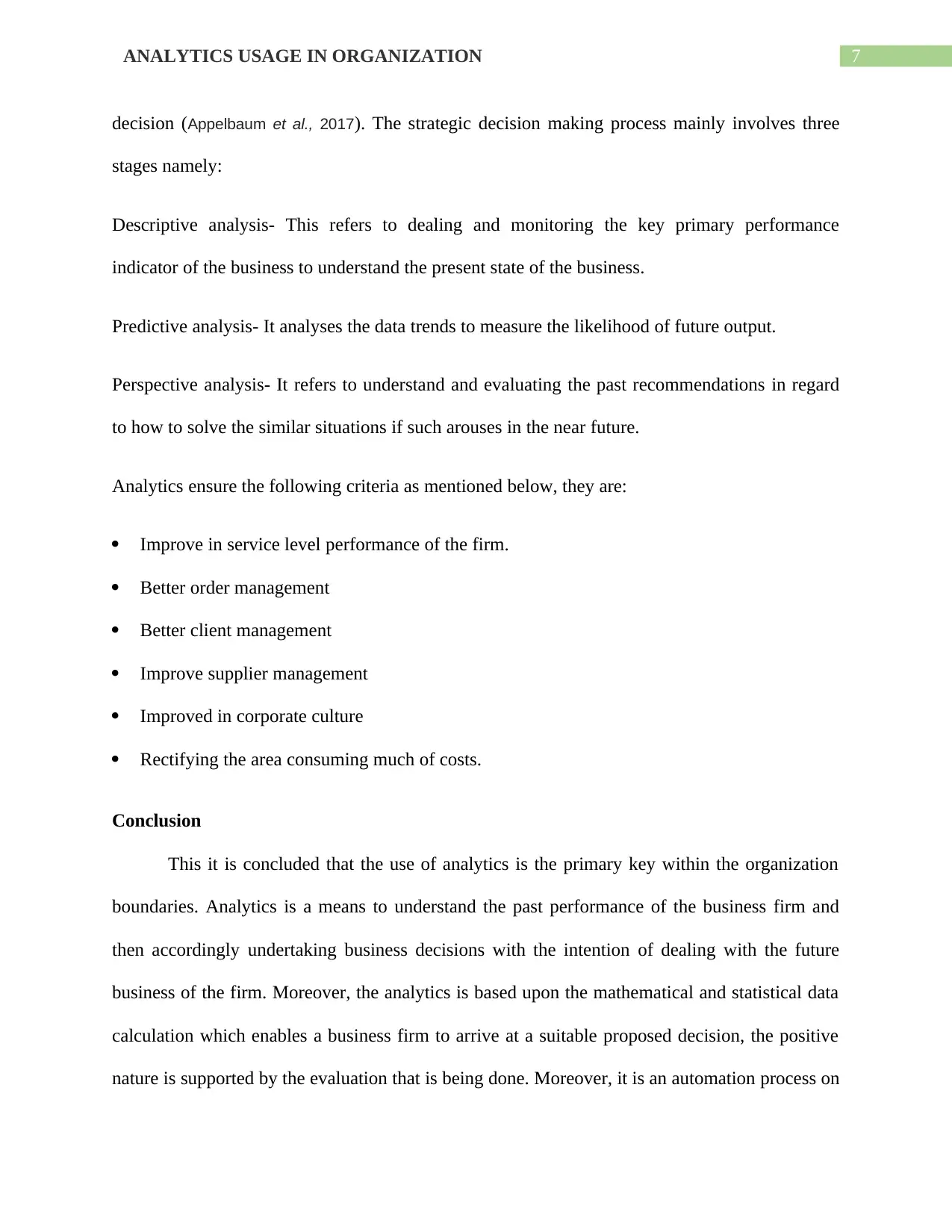
7ANALYTICS USAGE IN ORGANIZATION
decision (Appelbaum et al., 2017). The strategic decision making process mainly involves three
stages namely:
Descriptive analysis- This refers to dealing and monitoring the key primary performance
indicator of the business to understand the present state of the business.
Predictive analysis- It analyses the data trends to measure the likelihood of future output.
Perspective analysis- It refers to understand and evaluating the past recommendations in regard
to how to solve the similar situations if such arouses in the near future.
Analytics ensure the following criteria as mentioned below, they are:
Improve in service level performance of the firm.
Better order management
Better client management
Improve supplier management
Improved in corporate culture
Rectifying the area consuming much of costs.
Conclusion
This it is concluded that the use of analytics is the primary key within the organization
boundaries. Analytics is a means to understand the past performance of the business firm and
then accordingly undertaking business decisions with the intention of dealing with the future
business of the firm. Moreover, the analytics is based upon the mathematical and statistical data
calculation which enables a business firm to arrive at a suitable proposed decision, the positive
nature is supported by the evaluation that is being done. Moreover, it is an automation process on
decision (Appelbaum et al., 2017). The strategic decision making process mainly involves three
stages namely:
Descriptive analysis- This refers to dealing and monitoring the key primary performance
indicator of the business to understand the present state of the business.
Predictive analysis- It analyses the data trends to measure the likelihood of future output.
Perspective analysis- It refers to understand and evaluating the past recommendations in regard
to how to solve the similar situations if such arouses in the near future.
Analytics ensure the following criteria as mentioned below, they are:
Improve in service level performance of the firm.
Better order management
Better client management
Improve supplier management
Improved in corporate culture
Rectifying the area consuming much of costs.
Conclusion
This it is concluded that the use of analytics is the primary key within the organization
boundaries. Analytics is a means to understand the past performance of the business firm and
then accordingly undertaking business decisions with the intention of dealing with the future
business of the firm. Moreover, the analytics is based upon the mathematical and statistical data
calculation which enables a business firm to arrive at a suitable proposed decision, the positive
nature is supported by the evaluation that is being done. Moreover, it is an automation process on

8ANALYTICS USAGE IN ORGANIZATION
real time basis that continuously keeps on evaluating the data and after optimization arrive at a
specific decision. Data driven companies treat their business related data as business assets and
leverage it for means of corporate advantage. Successful business platforms depends upon
skilled data and skilled analytics who has a better understanding of the technology and the
business.
real time basis that continuously keeps on evaluating the data and after optimization arrive at a
specific decision. Data driven companies treat their business related data as business assets and
leverage it for means of corporate advantage. Successful business platforms depends upon
skilled data and skilled analytics who has a better understanding of the technology and the
business.
⊘ This is a preview!⊘
Do you want full access?
Subscribe today to unlock all pages.

Trusted by 1+ million students worldwide
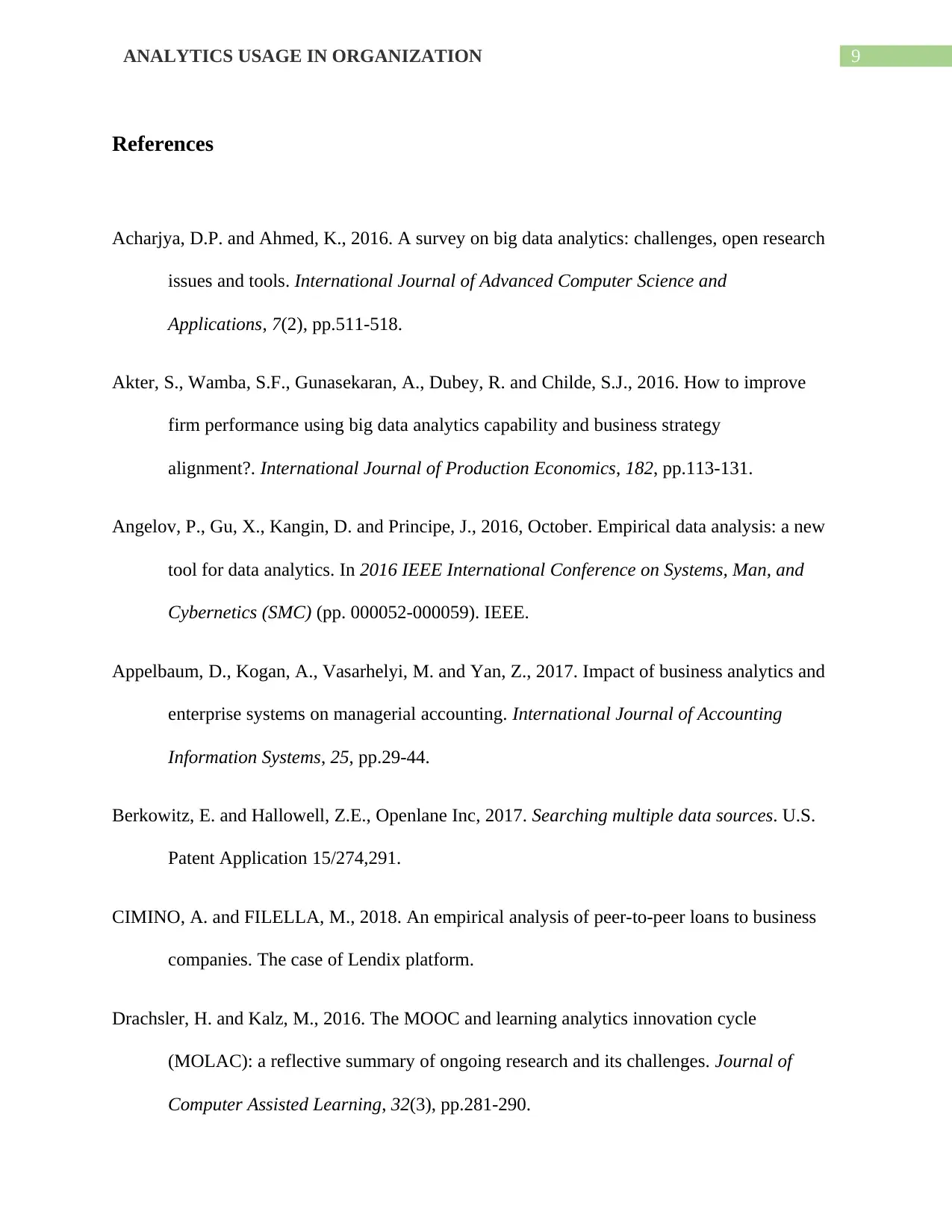
9ANALYTICS USAGE IN ORGANIZATION
References
Acharjya, D.P. and Ahmed, K., 2016. A survey on big data analytics: challenges, open research
issues and tools. International Journal of Advanced Computer Science and
Applications, 7(2), pp.511-518.
Akter, S., Wamba, S.F., Gunasekaran, A., Dubey, R. and Childe, S.J., 2016. How to improve
firm performance using big data analytics capability and business strategy
alignment?. International Journal of Production Economics, 182, pp.113-131.
Angelov, P., Gu, X., Kangin, D. and Principe, J., 2016, October. Empirical data analysis: a new
tool for data analytics. In 2016 IEEE International Conference on Systems, Man, and
Cybernetics (SMC) (pp. 000052-000059). IEEE.
Appelbaum, D., Kogan, A., Vasarhelyi, M. and Yan, Z., 2017. Impact of business analytics and
enterprise systems on managerial accounting. International Journal of Accounting
Information Systems, 25, pp.29-44.
Berkowitz, E. and Hallowell, Z.E., Openlane Inc, 2017. Searching multiple data sources. U.S.
Patent Application 15/274,291.
CIMINO, A. and FILELLA, M., 2018. An empirical analysis of peer-to-peer loans to business
companies. The case of Lendix platform.
Drachsler, H. and Kalz, M., 2016. The MOOC and learning analytics innovation cycle
(MOLAC): a reflective summary of ongoing research and its challenges. Journal of
Computer Assisted Learning, 32(3), pp.281-290.
References
Acharjya, D.P. and Ahmed, K., 2016. A survey on big data analytics: challenges, open research
issues and tools. International Journal of Advanced Computer Science and
Applications, 7(2), pp.511-518.
Akter, S., Wamba, S.F., Gunasekaran, A., Dubey, R. and Childe, S.J., 2016. How to improve
firm performance using big data analytics capability and business strategy
alignment?. International Journal of Production Economics, 182, pp.113-131.
Angelov, P., Gu, X., Kangin, D. and Principe, J., 2016, October. Empirical data analysis: a new
tool for data analytics. In 2016 IEEE International Conference on Systems, Man, and
Cybernetics (SMC) (pp. 000052-000059). IEEE.
Appelbaum, D., Kogan, A., Vasarhelyi, M. and Yan, Z., 2017. Impact of business analytics and
enterprise systems on managerial accounting. International Journal of Accounting
Information Systems, 25, pp.29-44.
Berkowitz, E. and Hallowell, Z.E., Openlane Inc, 2017. Searching multiple data sources. U.S.
Patent Application 15/274,291.
CIMINO, A. and FILELLA, M., 2018. An empirical analysis of peer-to-peer loans to business
companies. The case of Lendix platform.
Drachsler, H. and Kalz, M., 2016. The MOOC and learning analytics innovation cycle
(MOLAC): a reflective summary of ongoing research and its challenges. Journal of
Computer Assisted Learning, 32(3), pp.281-290.
Paraphrase This Document
Need a fresh take? Get an instant paraphrase of this document with our AI Paraphraser
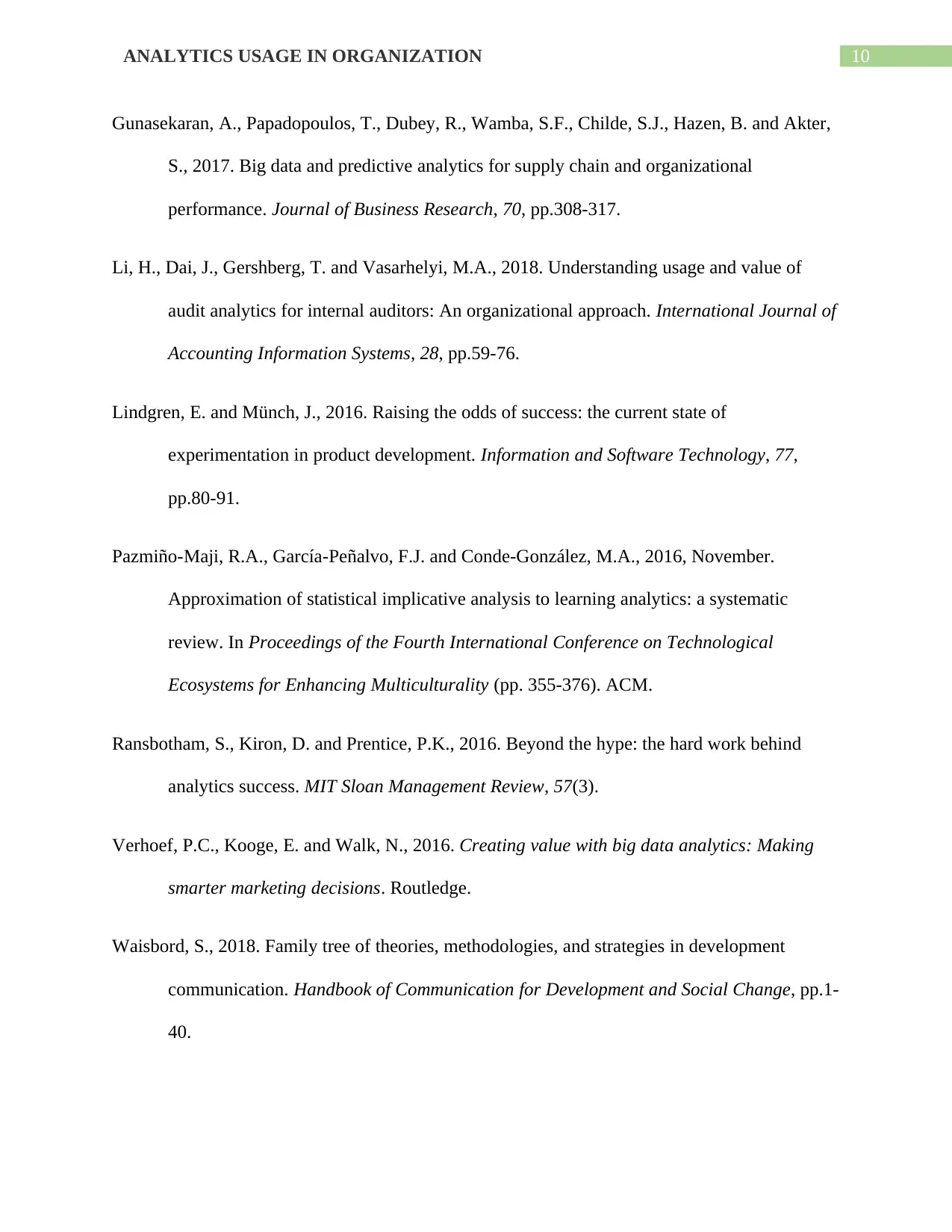
10ANALYTICS USAGE IN ORGANIZATION
Gunasekaran, A., Papadopoulos, T., Dubey, R., Wamba, S.F., Childe, S.J., Hazen, B. and Akter,
S., 2017. Big data and predictive analytics for supply chain and organizational
performance. Journal of Business Research, 70, pp.308-317.
Li, H., Dai, J., Gershberg, T. and Vasarhelyi, M.A., 2018. Understanding usage and value of
audit analytics for internal auditors: An organizational approach. International Journal of
Accounting Information Systems, 28, pp.59-76.
Lindgren, E. and Münch, J., 2016. Raising the odds of success: the current state of
experimentation in product development. Information and Software Technology, 77,
pp.80-91.
Pazmiño-Maji, R.A., García-Peñalvo, F.J. and Conde-González, M.A., 2016, November.
Approximation of statistical implicative analysis to learning analytics: a systematic
review. In Proceedings of the Fourth International Conference on Technological
Ecosystems for Enhancing Multiculturality (pp. 355-376). ACM.
Ransbotham, S., Kiron, D. and Prentice, P.K., 2016. Beyond the hype: the hard work behind
analytics success. MIT Sloan Management Review, 57(3).
Verhoef, P.C., Kooge, E. and Walk, N., 2016. Creating value with big data analytics: Making
smarter marketing decisions. Routledge.
Waisbord, S., 2018. Family tree of theories, methodologies, and strategies in development
communication. Handbook of Communication for Development and Social Change, pp.1-
40.
Gunasekaran, A., Papadopoulos, T., Dubey, R., Wamba, S.F., Childe, S.J., Hazen, B. and Akter,
S., 2017. Big data and predictive analytics for supply chain and organizational
performance. Journal of Business Research, 70, pp.308-317.
Li, H., Dai, J., Gershberg, T. and Vasarhelyi, M.A., 2018. Understanding usage and value of
audit analytics for internal auditors: An organizational approach. International Journal of
Accounting Information Systems, 28, pp.59-76.
Lindgren, E. and Münch, J., 2016. Raising the odds of success: the current state of
experimentation in product development. Information and Software Technology, 77,
pp.80-91.
Pazmiño-Maji, R.A., García-Peñalvo, F.J. and Conde-González, M.A., 2016, November.
Approximation of statistical implicative analysis to learning analytics: a systematic
review. In Proceedings of the Fourth International Conference on Technological
Ecosystems for Enhancing Multiculturality (pp. 355-376). ACM.
Ransbotham, S., Kiron, D. and Prentice, P.K., 2016. Beyond the hype: the hard work behind
analytics success. MIT Sloan Management Review, 57(3).
Verhoef, P.C., Kooge, E. and Walk, N., 2016. Creating value with big data analytics: Making
smarter marketing decisions. Routledge.
Waisbord, S., 2018. Family tree of theories, methodologies, and strategies in development
communication. Handbook of Communication for Development and Social Change, pp.1-
40.
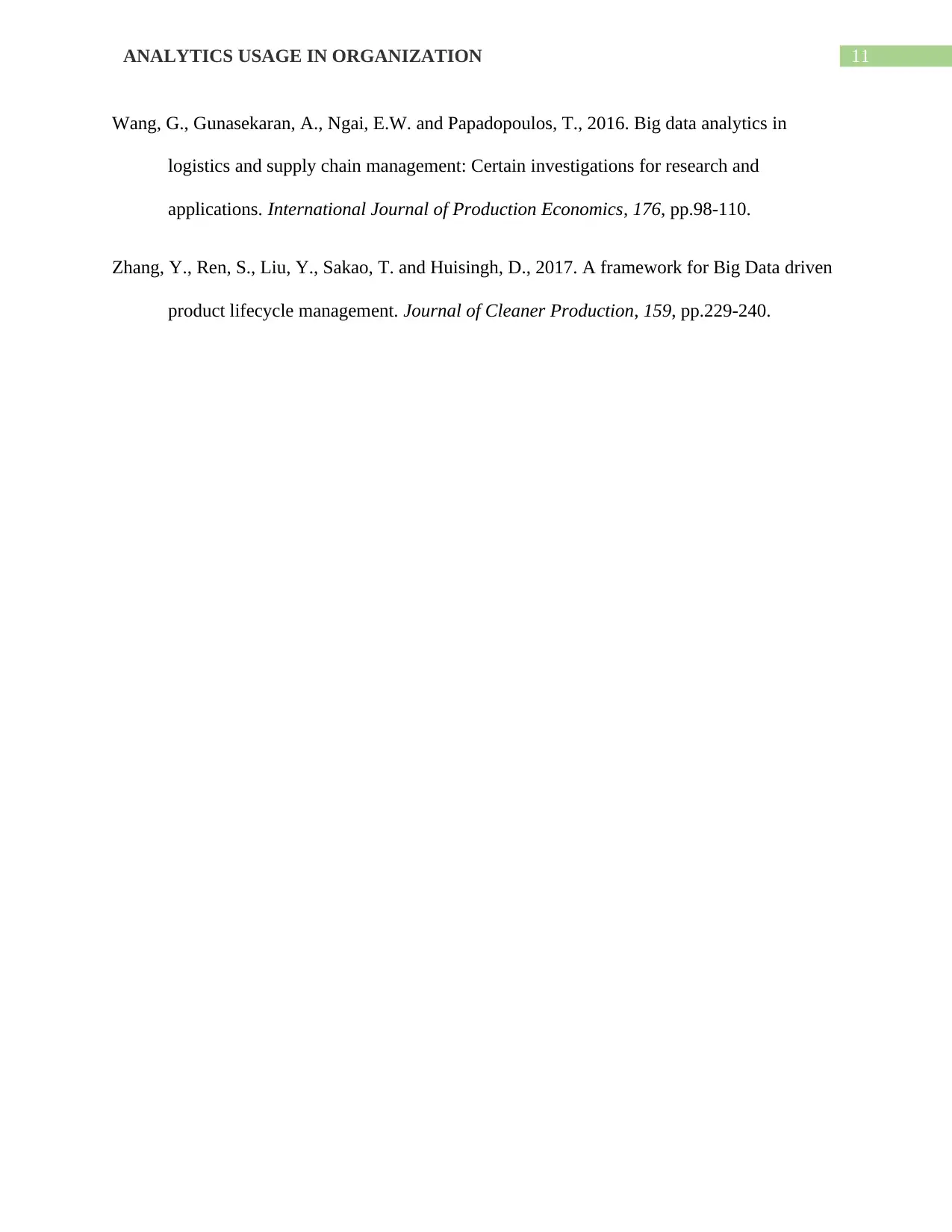
11ANALYTICS USAGE IN ORGANIZATION
Wang, G., Gunasekaran, A., Ngai, E.W. and Papadopoulos, T., 2016. Big data analytics in
logistics and supply chain management: Certain investigations for research and
applications. International Journal of Production Economics, 176, pp.98-110.
Zhang, Y., Ren, S., Liu, Y., Sakao, T. and Huisingh, D., 2017. A framework for Big Data driven
product lifecycle management. Journal of Cleaner Production, 159, pp.229-240.
Wang, G., Gunasekaran, A., Ngai, E.W. and Papadopoulos, T., 2016. Big data analytics in
logistics and supply chain management: Certain investigations for research and
applications. International Journal of Production Economics, 176, pp.98-110.
Zhang, Y., Ren, S., Liu, Y., Sakao, T. and Huisingh, D., 2017. A framework for Big Data driven
product lifecycle management. Journal of Cleaner Production, 159, pp.229-240.
⊘ This is a preview!⊘
Do you want full access?
Subscribe today to unlock all pages.

Trusted by 1+ million students worldwide
1 out of 12
Related Documents
Your All-in-One AI-Powered Toolkit for Academic Success.
+13062052269
info@desklib.com
Available 24*7 on WhatsApp / Email
![[object Object]](/_next/static/media/star-bottom.7253800d.svg)
Unlock your academic potential
Copyright © 2020–2025 A2Z Services. All Rights Reserved. Developed and managed by ZUCOL.





